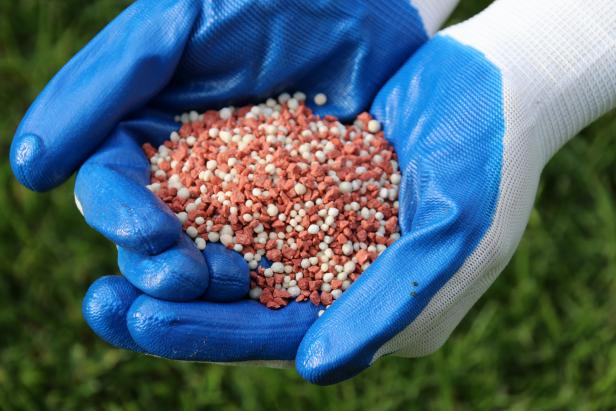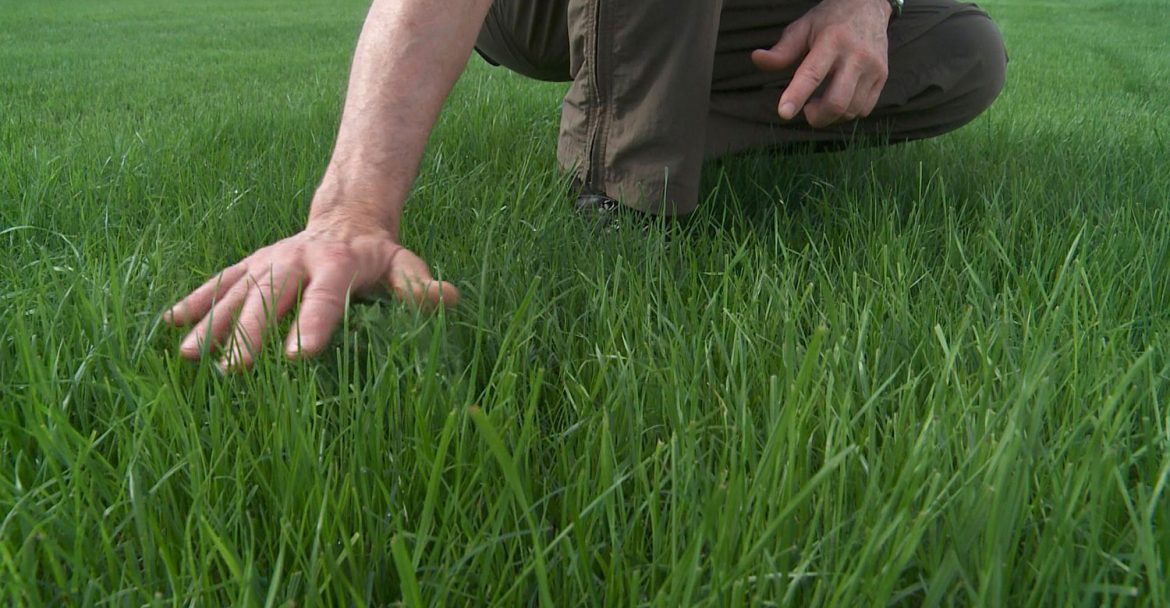Give your yard the perfect finishing touch by growing gorgeous green grass. A lush, healthy lawn is the secret to making landscape plantings sparkle, and it’s not tough to come by. It starts with feeding — giving your grass the nutrition it needs, when it needs it.
Growing healthy turf pays off in more ways than looking good. A stand of thick grass also crowds out weeds, stands up to drought and holds its own through seasonal temperature extremes. Want to tend your best lawn ever? Take our crash course on lawn fertilizing basics.

Fertilizer Basics
When you go to buy lawn fertilizer, it can be somewhat overwhelming. Here’s what you need to know to make the task easier.
- Bag size. In most cases, DIY lawn fertilizer programs feature granular products that come in bags measured in 5,000-square-foot increments. (One small bag treats 5,000 square feet of lawn.) Before shopping for fertilizer, calculate roughly how much lawn area you need to treat.
- Weed killer. Some lawn food also contains herbicide — something to kill lawn weeds. That type of fertilizer often limits when you can sow grass seed or sprig a new lawn. If you’re renovating your lawn by overseeding or planting plugs, check with your local extension service to make sure you buy the right kind of fertilizer. Otherwise, you risk killing the new grass.
- Mowing and rain. Check the bag for the best application conditions. With most lawn fertilizer, you should mow a few days before applying and not mow for a day or two after. Lawn fertilizer usually needs to be watered in. Time it before rainfall, and let nature help wash the granules down through grass blades to the soil. With lawn fertilizers that contain weed killer, you usually need to apply it when grass is moist (in early morning, when dew is present) and rain isn’t expected for a certain timeframe. All of this is spelled out on the bag.
- Spills and sprays. Avoid spilling fertilizer on grass as you fill your spreader. A big pile of fertilizer can burn and even kill grass. If you do spill it, sweep the granules out into surrounding lawn as far as you can. An easy way to avoid spills is to fill your spreader on a tarp. If any granules get on concrete drives or walks, sweep it back into the grass. Most fertilizers won’t stain these surfaces, but some do. This is stated on the bag, but it’s safest to sweep surfaces clean.

What You Need
Use a spreader to apply lawn fertilizer. A handheld spreader works for a small lawn area, as does a drop spreader. With large swaths of lawn, a push broadcast spreader is the go-to choice. To set your spreader to the right rate, look for the brand name or type of spreader on the fertilizer bag. If you’re still stumped, search online or check in with your local extension office.
Time It Right
Timing is the most important aspect of fertilizing your lawn. In general, the type of grass you have — cool season or warm season — determines when you want to fertilize. (Learn more about grass types below.) Your goal is to give grass food as it enters its annual season of strong growth. With cool-season lawns, that means feeding starts in early spring, about the time of your first mowing. Warm season lawns grow most intensely during summer heat, so you want to feed just before the heat arrives.
Cool-season lawns also benefit from a late fall feeding known as a winterizer. This fertilizer helps to nourish grass roots so that they’ll survive winter and jump-start growth in spring. Many turf professionals suggest that if you only feed your lawn once a year, it should be the winterizer fertilizer because it provides a very balanced nutrient mix.
Traditional DIY lawn feeding programs offer a price break if you buy multiple bags of fertilizer to treat your lawn all through the growing season (early spring, late spring, summer, fall). Sometimes these pre-set feeding regimes include a pesticide, which your lawn may not need. With these programs, you often wind up applying more fertilizer than your grass really needs. Too much lawn fertilizer can lead to problems in local waterways, including things like algae blooms and red tides. The best way to know how often to feed your lawn is to check with your local extension office.
Types of Grass
Turfgrass is divided into two types:
- Cool-season grass types include fescue, bluegrass and perennial ryegrass. Cool season grasses grow best at temps of 60°F to 75°F in areas with cold winters (roughly Zones 5 and colder).
- Warm season types include bahia, Bermuda, St. Augustine, centipede and zoysia. Warm season grasses typically thrive in frost-free areas and grow best at temps of 75°F to 90°F.
Source / HGTV

